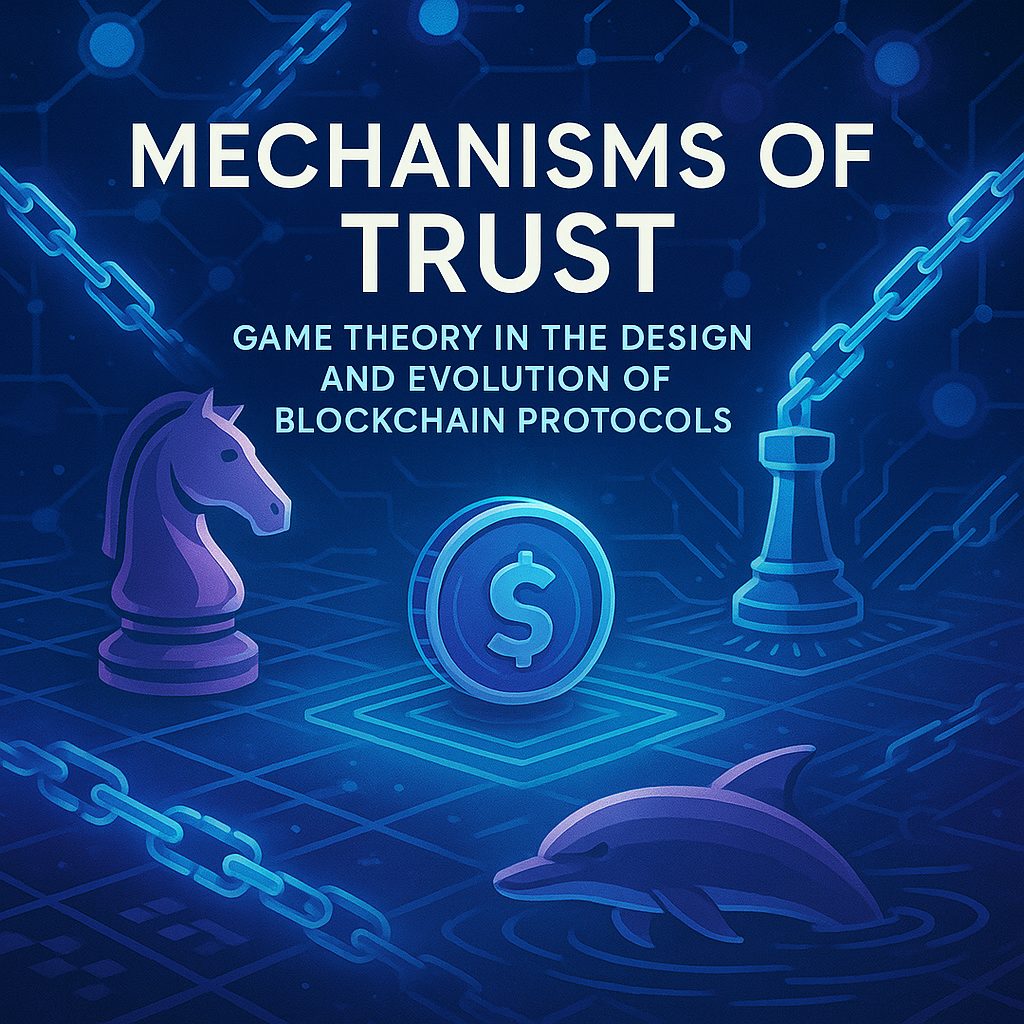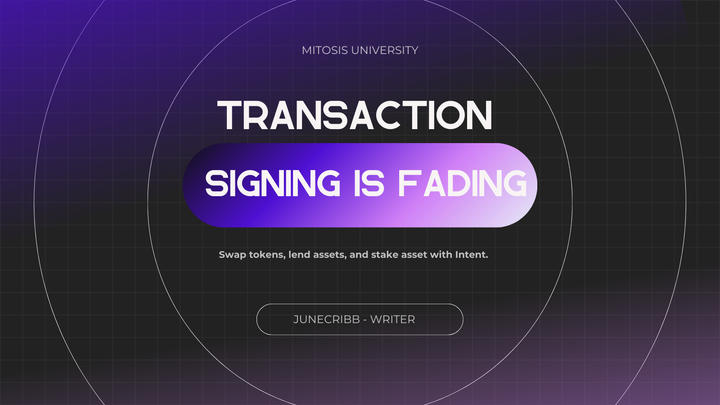Mechanisms of Trust: Game Theory in the Design and Evolution of Blockchain Protocols

Abstract
Blockchain technology addresses a core challenge in distributed systems: achieving consensus among anonymous, distrustful participants. By applying game theory, protocols such as Bitcoin and Ethereum create incentive mechanisms that align individual rational behavior with the overall security and stability of the network. This article offers a thorough examination of Proof-of-Work (PoW) and Proof-of-Stake (PoS) consensus models, analyzing their incentive structures, inherent vulnerabilities, and enduring issues like state bloat and transaction fee dynamics. Using case studies from Bitcoin, Ethereum, Cosmos, Polkadot, and Nervos CKB, we demonstrate how carefully crafted mechanism design enables trustless coordination and reveal ongoing innovations shaping the future of blockchain protocol development.
Introduction: The Coordination Challenge
Public blockchains solve a classic problem in distributed computing known as the Byzantine Generals’ Problem, where a group of generals, separated by distance and unable to fully trust each other, must agree on a unified plan of attack (Cointelegraph). Traditional solutions required a majority of honest actors with known identities, but blockchains like Bitcoin achieve coordination in a trustless, permissionless environment where participants are anonymous and act in their self-interest. This breakthrough relies on game theory, the study of strategic interactions among rational decision-makers, defined by players (the actors), strategies (their possible actions), and payoffs (the resulting rewards or consequences) (Caleb & Brown).
Blockchains are meticulously designed games, using mechanism design to craft rules that make honest behavior the most profitable strategy, ensuring network security and stability (arXiv). For example, imagine a traffic light where drivers follow signals to avoid collisions; no one gains by running a red light if others comply, creating a stable state akin to a Nash Equilibrium, where no player benefits by changing strategy alone (CORE). This article examines the game-theoretic foundations of PoW and PoS, analyzing their incentive structures, vulnerabilities, and challenges like state bloat and transaction fee markets. Drawing on real-world examples, we highlight how these protocols balance individual and collective interests and explore future directions for sustainable blockchain design.
Proof-of-Work: Computation as Commitment
Proof-of-Work (PoW), as implemented in Bitcoin, secures the network by requiring participants, known as miners, to expend computational power, translating to real-world costs in hardware and electricity. This costly commitment ensures that honest participation is more profitable than subversion (Kraken).
The Miner’s Dilemma: Incentives and Nash Equilibrium
In PoW, miners, often organized into mining pools, are rational economic actors aiming to maximize profit (SALT Lending). Their strategies include:
- Honest Mining: Adhering to protocol rules, extending the longest valid chain, and including legitimate transactions.
- Strategic Transaction Selection: Choosing transactions to include in a block, balancing higher fees from more transactions against the risk of slower block propagation, which could result in losing the block reward (ResearchGate).
- Dishonest Strategies: Exploiting rules through attacks like selfish mining or 51% attacks, discussed later.
The payoff is the block reward, comprising a fixed block subsidy (e.g., 6.25 BTC after the 2020 halving, 3.125 BTC post-2024) and variable transaction fees. A miner’s chance of earning this reward is proportional to their share of the network’s total hashrate. Game-theoretic models reveal a counterintuitive finding: when the block subsidy outweighs transaction fees, miners may produce empty blocks to minimize propagation delays, maximizing their chance of winning the subsidy. This strategy, while rational, conflicts with the network’s role as a payment system (ResearchGate).
In a Nash Equilibrium, where no player benefits by unilaterally changing their strategy—like drivers obeying a traffic light—honest mining is typically optimal if no single miner controls a dominant hashrate share. This equilibrium depends on external factors like Bitcoin’s market price, electricity costs, and hardware efficiency (SALT Lending). Miners participate only if expected rewards exceed costs, creating a “happy Nash equilibrium” where competition among profit-seeking miners secures the network.
However, a tension exists between individual profit and network utility. Miners’ preference for smaller blocks clashes with users’ need for high transaction throughput. As the block subsidy decreases with each halving, transaction fees will dominate, intensifying this conflict and posing a long-term challenge to Bitcoin’s security (Bitcoin Magazine). The 2014 case of the GHash.io pool, which voluntarily reduced its hashrate when approaching 51% to avoid crashing Bitcoin’s value, illustrates a game-theoretic deterrent: a successful attack would devalue the attacker’s investment in specialized hardware and holdings, creating a scenario of mutually assured destruction (CCN).
Bitcoin’s Difficulty Adjustment: A Dynamic Stabilizer
Bitcoin’s difficulty adjustment recalibrates the cryptographic puzzle’s complexity every 2,016 blocks (approximately two weeks) to maintain a 10-minute average block time. If blocks are mined faster, difficulty increases; if slower, it decreases (Bitcoin Wiki). This mechanism serves as an economic governor that:
- Regulates Competition: Rising Bitcoin prices or improved mining technology increase hashrate, but the difficulty adjustment raises puzzle complexity, stabilizing reward issuance (arXiv).
- Maintains Attack Costs: High difficulty ensures that a 51% attack remains costly, especially for large networks like Bitcoin (Bitcoin Wiki).
- Create Strategic Tension: If Bitcoin’s price falls or energy costs rise, less efficient miners may exit, reducing hashrate. The subsequent difficulty reduction restores profitability for remaining miners (Bitcoin Wiki).
This mechanism anchors Bitcoin’s ledger to real-world constraints, ensuring predictable coin issuance and enabling global coordination (BTC Policy). However, it introduces vulnerabilities. Attackers can manipulate the difficulty adjustment through selfish mining, withholding blocks to make the chain appear slower, triggering a lower difficulty that benefits them.
Attack Vectors: 51% Attacks and Selfish Mining
PoW incentivizes honesty, but rational actors can exploit vulnerabilities.
51% Attack
A 51% attack occurs when a miner or group controls over 50% of the hashrate, allowing them to build a longer private chain that the network adopts, enabling double-spending or transaction censorship (Investopedia). For Bitcoin, the cost of such an attack is prohibitive, often billions of dollars, and a successful attack could crash Bitcoin’s price, devaluing the attacker’s investment. Smaller PoW networks are more vulnerable due to hashrate rental markets, which allow attackers to rent temporary hashrate for short-term, profitable attacks, as seen in smaller cryptocurrencies (MIT DCI).
Selfish Mining
Selfish mining involves withholding newly mined blocks to gain an advantage (Investopedia). An attacker mines a block privately and continues mining the next block. If the honest network finds a competing block, the attacker broadcasts their block, exploiting network latency to orphan the honest block (IFCA). This strategy can be profitable with as little as one-third of the hashrate, especially with strong network connectivity, and is amplified by manipulating the difficulty adjustment (arXiv). Selfish mining transforms PoW into a strategic contest of information control, highlighting its dependence on timely block propagation (IFCA).
PoW’s security assumes long-term rational actors with significant investments. Short-term actors using rented hashrate can disrupt smaller networks without concern for long-term consequences (SciSpace).
Proof-of-Stake: Capital as Commitment
Proof-of-Stake (PoS) replaces computational power with staked capital, where validators lock up cryptocurrency to participate in consensus. This internalizes security costs, making PoS more energy-efficient but introducing new complexities.
Validator’s Gambit: Staking and Rewards
Validators stake coins as collateral, earning the right to propose and validate blocks based on their stake size. Rewards include transaction fees and, in many systems, newly issued tokens, incentivizing honesty to protect the validator’s investment. Unlike PoW’s external costs, PoS’s security relies on the threat of losing staked capital. However, liquid staking protocols, where token holders delegate stakes to third-party validators, introduce a principal-agent problem. Validators may face minimal risk while delegators bear the financial loss, potentially centralizing stake control (arXiv).
Comparing PoW and PoS
PoS fundamentally differs from PoW in its resource use and security model, as summarized below:
Table 1: Comparing PoW and PoS Consensus Mechanisms
Game-Theoretic Dimension | Proof-of-Work (PoW) | Proof-of-Stake (PoS) |
|---|---|---|
Scarce Resource | Computational Power (Hashrate) | Capital (Staked Coins) |
Basis of Security | Deterrence by Cost (Energy/Hardware Expenditure) | Deterrence by Punishment (Forfeitable Stake) |
Cost of Attack | External and Consumed (Electricity) | Internal and Forfeitable (Slashed Capital) |
Primary Attack Vector | 51% Hashrate Attack | 51% Stake Attack, Long-Range Attack |
Decentralization Pressure | Toward cheap energy; Centralization in hardware (ASICs) and pools | Toward capital concentration (“rich get richer”); Centralization in staking pools and liquid staking platforms |
Key Vulnerability | Profitability of short-term attacks via rented hashrate on smaller chains | “Nothing-at-Stake” problem; Long-range attacks requiring social consensus to mitigate |
Table 1 compares the game-theoretic properties of PoW and PoS, highlighting their distinct approaches to security and vulnerabilities .
PoS internalizes security costs through slashing, where malicious actions lead to the loss of staked capital, unlike PoW’s indirect market-based penalties (CCN). This makes PoS more efficient but reliant on complex incentive alignment.
Slashing as a Punitive Deterrent
Slashing is PoS’s primary enforcement mechanism, imposing severe penalties for malicious behavior to align validators’ interests with network security. Common slashable offenses include:
Table 2: Slashable Offenses and Penalties in Major PoS Networks
Offense | Description | Example Networks | Example Penalty |
|---|---|---|---|
Double-Signing / Equivocation | Signing two different blocks at the same height or making conflicting attestations, threatening a chain fork. | Ethereum, Cosmos, Polkadot | Ethereum: ≥1 ETH slashed & ejection from validator set. Cosmos: 5% of stake slashed & validator “tombstoned” (permanently banned). |
Downtime / Inactivity | Failing to participate in consensus for an extended period, harming network liveness. | Cosmos, Polkadot, Ethereum | Cosmos: 0.01% of stake slashed for missing ~10,000 blocks. Polkadot: Small penalty, collective if many are offline. |
Surround Voting | Making an attestation that violates finality rules by “surrounding” a previous vote. | Ethereum | Treated as a double-signing offense, leading to slashing and ejection. |
Table 2 outlines slashable offenses in PoS networks, showing how penalties deter malicious behavior.
Slashing acts as a “nuclear deterrent,” rarely triggered but highly effective. Ethereum data shows slashing events are typically due to misconfiguration rather than malice (Symbiotic). Correlated penalties, which increase with the number of offending validators, deter coordinated attacks (Eth2 Book). This creates a “game of professionalism,” where delegators choose reliable validators, enhancing network robustness. However, overly harsh penalties risk discouraging smaller validators, potentially centralizing the network.
Vulnerabilities: Nothing-at-Stake and Long-Range Attacks
PoS introduces unique vulnerabilities due to its reliance on internal capital.
Nothing-at-Stake Problem
In early PoS systems, validators could sign blocks on multiple forks at no cost, preventing definitive consensus. Modern protocols counter this by making equivocation a slashable offense, attaching significant economic costs to such behavior.
Long-Range Attacks
Long-range attacks involve an attacker using old validator keys to create an alternative blockchain history from an early point, like forging an old library book to deceive new readers. Since PoS requires minimal computational work, new nodes syncing from the genesis block cannot algorithmically distinguish the malicious chain. Mitigations include:
- Checkpointing and Economic Finality: Ethereum’s Casper finalizes blocks with a supermajority of validator attestations, making reversals costly, akin to librarians confirming the correct book version.
- Weak Subjectivity: New nodes rely on trusted recent checkpoints from the community, introducing a social component to PoS security.
Unlike PoW’s objective security based on accumulated work, PoS depends on cryptoeconomic incentives and social consensus.
The Tragedy of the Digital Commons
Beyond block production, blockchains manage shared digital resources, raising challenges similar to a “Tragedy of the Commons” (Frontiers).
State Bloat: A Chronic Threat to Decentralization
A blockchain’s state—account balances, smart contract code, and storage—is a common pool resource susceptible to overuse, known as state bloat. Users pay one-time transaction fees to write data, but full nodes bear perpetual storage costs, incentivizing over-consumption. This increases hardware and bandwidth requirements, threatening decentralization as only well-funded entities can afford to run nodes (CryptoEQ). If unaddressed, state bloat could undermine trustless verification, compromising blockchains’ core value proposition.
Transaction Fee Markets: Ethereum’s EIP-1559
Transaction fee markets are critical to blockchain efficiency, with Ethereum’s EIP-1559 as a key case study. The legacy first-price auction encouraged bid-shading and off-chain collusion, leading to volatile fees (HackerNoon). EIP-1559 introduced:
- A protocol-determined base fee, burned rather than paid to validators.
- A user-defined priority fee (tip) for faster inclusion.
- Variable-sized blocks to handle demand spikes.
Table 3: Game-Theoretic Comparison of Transaction Fee Mechanisms
Game-Theoretic Property | First-Price Auction (Legacy) | EIP-1559 |
|---|---|---|
User Incentive Compatibility | Low (encourages bid-shading and guesswork) | High (encourages truthful bidding of max fee) |
Validator Incentive Compatibility | High (incentivized to include highest-fee transactions) | High (incentivized to include highest-tip transactions) |
Collusion Resistance | Low (incentive for off-chain deals) | High (base fee burning removes collusion incentive) |
Price Predictability / UX | Poor (volatile fees) | Good (base fee provides clear price signal) |
Table 3 compares Ethereum’s legacy fee mechanism with EIP-1559, highlighting improvements in user experience and collusion resistance.
By burning the base fee, EIP-1559 reduces validator incentives to manipulate fees, improves predictability, and creates deflationary pressure on ETH (Tim Roughgarden). This redesign exemplifies applied mechanism design, balancing user experience and network security (Galaxy).
Sustainable State Management: State Rent and Alternatives
Addressing state bloat requires rethinking storage economics. State rent proposes recurring fees proportional to data size and storage duration, internalizing costs and allowing pruning of unmaintained data (Delphi Digital). Nervos CKB ties state occupancy to token ownership, where one byte of state requires one CKB token. Users not occupying state can lock tokens in a special contract, earning inflation rewards, effectively taxing those who store data and encouraging efficient state use. These models shift from perpetual ownership to leasable space, raising questions about user experience, such as what happens to assets if rent isn’t paid, highlighting a philosophical divide in blockchain design (Delphi Digital). Balancing sustainability and usability remains a core challenge.
Conclusion: Driving Blockchain’s Future with Game-Theoretic Innovation
Blockchain consensus mechanisms are intricate economic systems designed to align self-interested actors toward collective goals. PoW achieves robust security through computational expenditure but is energy-intensive, while PoS offers efficiency through staked capital but relies on complex incentives and social consensus (arXiv). The design of these protocols is an ongoing arms race, where developers must anticipate and counter strategies of rational actors exploiting vulnerabilities. A philosophical divide further complicates this: should blockchains prioritize perpetual digital ownership, offering simplicity for users, or adopt leasable state models to ensure long-term sustainability?.
Future blockchain innovations include hybrid PoW-PoS models that blend PoW’s security with PoS’s efficiency, dynamic reputation systems to reduce stake centralization, and AI tools to detect attacks and improve consensus. These advances highlight the need for collaboration across game theory, economics, and computer science. To ensure long-term viability, developers should focus on sustainable designs like state rent, researchers on AI-driven consensus, and communities on balancing decentralization with usability—building resilient systems for a trustless, complex digital future.
References
- arXiv, https://arxiv.org/pdf/1902.10865
- Bitcoin Wiki, https://en.bitcoin.it/wiki/Difficulty
- Bitcoin Magazine, https://bitcoinmagazine.com/technical/the-game-theory-of-a-strategic-bitcoin-reserve
- BTC Policy, https://www.btcpolicy.org/articles/bitcoin-and-the-genius-of-the-difficulty-adjustment
- Caleb & Brown, https://calebandbrown.com/blog/the-game-theory-of-cryptocurrency/
- CCN, https://www.ccn.com/education/crypto/bitcoins-defense-mechanisms-max-sanchez-51-attack-decentralization-mining/
- Cointelegraph, https://cointelegraph.com/news/the-game-theory-of-bitcoin-and-cryptocurrencies
- CORE, https://core.ac.uk/download/pdf/187116015.pdf
- Delphi Digital, https://members.delphidigital.io/learn/state-rent
- Eth2 Book, https://eth2book.info/latest/part2/incentives/slashing/
- Galaxy, https://www.galaxy.com/insights/research/eip-1559-major-ethereum-upgrade
- Investopedia, https://www.investopedia.com/terms/1/51-attack.asp
- MIT DCI, https://www.dci.mit.edu/projects/51-percent-attacks
- ResearchGate, https://www.researchgate.net/publication/311864039_The_Bitcoin_Mining_Game
- SALT Lending, https://saltlending.com/game-theory-and-bitcoin/
- SciSpace, https://scispace.com/pdf/the-51-attack-on-blockchains-a-mining-behavior-study-14y7lt1tix.pdf
- Symbiotic, https://blog.symbiotic.fi/demystifying-slashing/
- Tim Roughgarden, https://timroughgarden.org/papers/eip1559.pdf
Similar Articles
The Ethics of Immutability: "Code is Law" and Its Consequences
🔒 Smart Contracts: Redefining Trust Through Code
From Anarchy to Autonomy: Reimagining Society Through Blockchain and Web3
Navigating GDPR and Public Blockchain: Challenges and Solutions
Privacy vs. Transparency: Balancing Blockchain’s Open Ledgers with Personal Rights
Tokenization of Real World Assets (RWA): How Blockchain Is Opening the Doors to Traditional Finance
The Tokenization of Everything: A New Paradigm for Value, Ownership, and Access
Blockchain as a Catalyst for Societal Change: Utopian Visions vs. Dystopian Realities



Comments ()